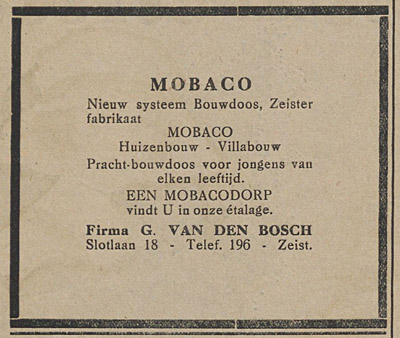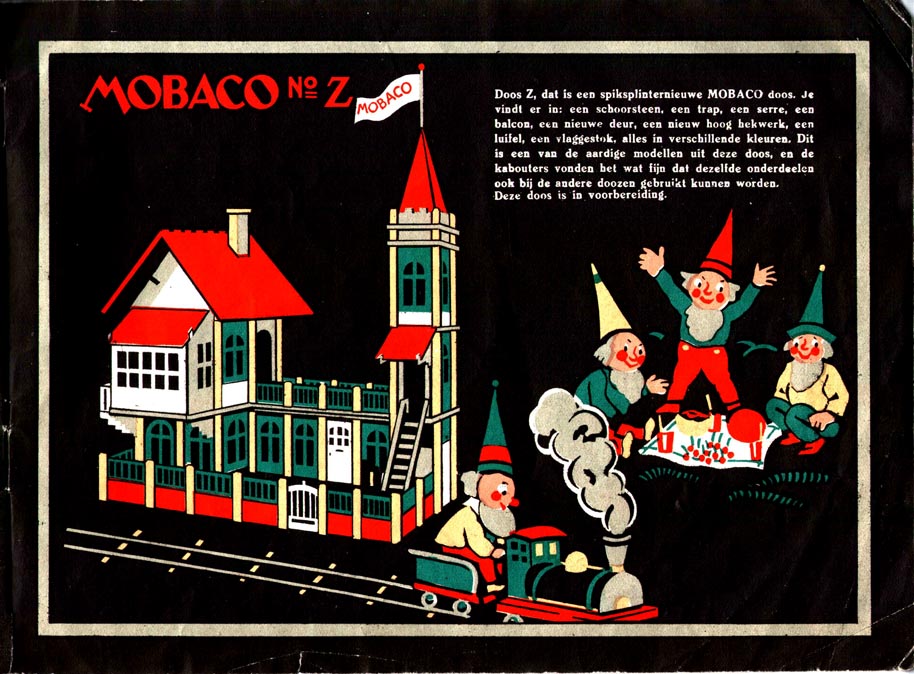
| INTRO | PARTS |
SETS Moubal Jumbo |
MANUALS Moubal Jumbo |
MARKETING |
PRICE LISTS | BUILDING |
MOUBAL RELATED |
 |
||||||||
|
 Oldest Mobaco advertisement found on the internet Zeister Courant, 18 October 1924 Translation: New construction set system, made in Zeist. MOBACO Build Houses - Build Villas Beautiful construction set for boys of every age. A MOBACO VILLAGE can be found in our display window.  Registered trade mark for MOBACO, listed under "Toys and in particular construction sets", issued 30 September 1924, and re-issued in 1944 and 1964. Document states that name is in use since 1 August 1924. (Courtesy Gerard Poot)  1926 listing by the United States Patent Office. Filed April 15, 1926, serial no. 230,251 Published September 7, 1926, no. 220,907. States: "Claims use since September 1, 1924" (source: Google Books)  Moubal Set Z, announced but never issued. |
HISTORY OF MOBACO SETS This is still a work in progress. With images from collectors and various auction sites, I'm trying to piece together the sets history. Please contact me if you know more or have corrections! (see Intro page) MOUBAL PERIOD In fall 1924, N.V. Plaatmetaalindustrie (= sheet metal factory) van Mouwerik & Bal started producing MOBACO sets. The Dutch trademark filing lists August 1, 1924 as the date the name was first used. In the US Patent Application, first use is claimed as September 1, 1924. The earliest sales advertisement I found was from 18 October 1924 (see adjacent). The history from 1924, when they came out with Set 1 and Set 2, to 1934, the first dated price list, is a little sketchy. However, based on a number of undated price lists, as well as some advertisements, we can assume that they first added Set 0 and Set 1a (the upgrade set from Set 1 to Set 2) in 1925, then Set 00 early in 1926. In the fall of 1926, they added Set 3, Set 4, Station No. 1 and Station No. 2. Then they added Set 2a (upgrade set from Set 2 to Set 3) in 1930 or 1931, and Set 000 (their smallest set) in 1932. So by 1934 they had increased the range to seven progressive sets (000, 00, 0, 1, 2, 3 and 4), two upgrade sets (1a and 2a), and two specialty sets (Train Station 1, Train Station 2). The upgrade sets had all the parts necessary to upgrade to the next largest set. So Set 1 + Set 1a = Set 2, and Set 2 + Set 2a = Set 3. In 1935, they added Set 01 and Garage 1 and Garage 2. Set 01 was a combination of Set 00 and Set 0, and still fell below Set 1. Garages 1 and 2 introduced a number of new parts, specific to these sets. In 1936, they reduced the number of parts in Set 1 (from 252 to 174), and increased the number of parts in upgrade Set 1a (from 203 to 282). This change brought the set prices more in line with the number of parts. The smaller Set 1 with its 174 parts was only slightly larger than Set 01 with 160 parts, but it had more of the larger parts. They also introduced a new upgrade Set 0a, so Set 0 + Set 0a equaled (roughly) the now smaller Set 1. In 1937, they discontinued the specialty sets Train Station 1, Train Station 2, Garage 1 and Garage 2, leaving the core of 8 progressive sets (000, 00, 0, 01, 1, 2, 3, 4) and 3 upgrade sets (0a, 1a, 2a). In 1938, they introduced the Small Garage, which was cheaper and smaller than the earlier Garage 1. This set was discontinued in 1942. Finally, they produced two Windmill sets, Windmill no. 1 and Windmill no. 2. Technically, they are not Mobaco sets, but are compatible with them. Like the Garage sets, the windmills included many special parts. They don't show up on any of the Mobaco price lists. However there are ads in 1936 and 1937 mentioning these sets, so they were probably introduced in 1936. Unlike the other sets, which were all packaged in maroon boxes, the Windmill sets had bright blue-green boxes and are not stamped Mobaco. These sets are rare and command a premium today. During the war Mobaco production ceased, although van Mouwerik en Bal continued production of sheet metal products. This little insert found in a Set 00 from 1942 or 1943 states: This is one of the last Mobaco sets that could still be made.  Image courtesy of Nick
Cranendonk
After the war, Moubal resumed production and sales of the 8 progressive sets and 3 upgrade sets, from 1948 through 1952. This table shows which sets were shown in which price list:  Availability of sets, based on Moubal price lists A color brochure mentions the introduction of Set Z, a set with several new parts including a chimney, a stairway, a conservatory, a balcony, a new entry door, a taller fence, a canopy and a flag pole, all in different colors, but this set was never produced. In 2021, Koos Welling and I worked out the design of these parts and Koos laser cut them. In 1934, Set 4 cost the princely sum of 42 guilders. By 1951, the price had climbed to 200 guilders. By comparison, in 1951 a Volkswagen Beetle cost ± 4,000 guilders, so Set 4 cost 1/20th of a car. Not surprisingly, they are extremely rare! The large instruction manual from the 1930's suggests that they may have envisioned an even bigger Set 5, but it never saw the light of day. Click here for more details about the Moubal sets JUMBO PERIOD After the war, people were dirt-poor, and Mobaco sales were slow. Rather than abandon Mobaco, Moubal entered into negotiations with Hausemann & Hötte NV in Amsterdam, owners of Jumbo, a Dutch puzzle, games and toy manufacturer. Jumbo relaunched Mobaco around 1949, first with a new, small "red" Set A, and shortly thereafter a series of 3 sets, Set A, Set B and Set C. In 1950, they changed that to a series of four progressive sets named A, B, C and D, with upgrade sets AB, BC and CD. These "complementary sets" included all the parts needed to upgrade to the next largest set. Contents of the new sets A, B and C were different from the initial Jumbo series. In 1951, they added Set E and make-up set DE. The manuals were also completely redone by Jumbo. Each model was now represented by a photograph and a parts list. Unlike the pre-war manuals, there were no assembly instructions. But models were much simpler, so that may not have been a problem. The initial series of manuals, also labeled A, B and C, confusingly did not correspond to sets A, B and C, they just showed models of increasing complexity, some requiring many sets. A new series of four manuals was made for the later A-B-C-D series, and these corresponded more closely to the parts in each set. In 1951, with the advent of Set E, Jumbo introduced a single manual, covering all sets (A-E). Jumbo introduced a few new parts, including a couple of trees. For the ABCDE series, they changed the column size from 1/2" (12.7 mm) to 12 mm, and adjusted the holes in the base plates accordingly. At some point, they changed the color of the base plate from tan to green, and changed the windows from square to gothic-style pointed arches. Parts numbering was a bit of a mess, as a result different parts sometimes have the same number, indicated in red in the table below. 1961 was the last year Mobaco was produced. All these years, production of the parts was still by van Mouwerik & Bal, although the boxes were probably made by Jumbo. Click here for more details about the Jumbo sets |
CONTENTS OF ALL MOBACO SETS |